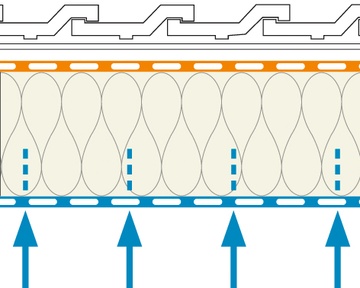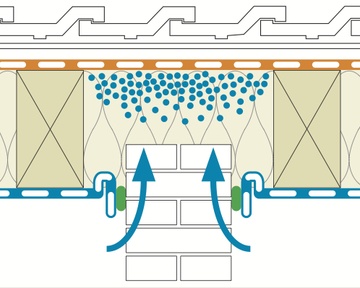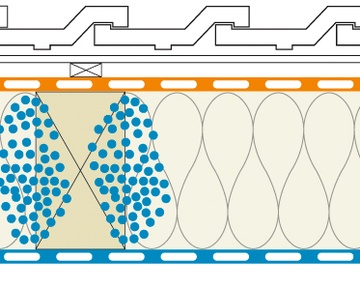Paths taken by Moisture
Thermal insulation structures have to be protected against the humidity loading from warm indoor air. This task is fulfilled by vapour retarder and airtight membranes.
Diffusion occurs in a planned manner
Diffusion: Diffusion takes place due to the pressure difference between the inside and outside. The exchange does not occur through gaps, but instead in the form of moisture passing through a monolithic, airtight material layer. Diffusion is generally from the inside to the outside in winter and from the outside to the inside in summer. The entry of moisture into the structure depends on the diffusion permeability (perm rate) or resistance in case of sd/g-value of the material. In Central Europe, the period with warm exterior temperatures is longer than the period with winter temperatures, which means that more moisture can dry out of the structure.

A vapour retarder with an sd-value of 2.3 m, g-value of 11.5 MNs/g respectively a water vapor permeance of 1.43 US perms allows approx. 5 g of moisture per square metre to penetrate into the building structure each day in winter according to DIN 4108-3.
Unforeseen: Air flow (Convection)
Convection: A flowing movement of air is referred to as convection. This can occur in thermal insulation structures if there are gaps in the vapour retarder layer. The temperature difference between the interior and exterior climates also leads to a pressure difference, which the air flow attempts to balance out.

Several hundred grams (dozens of ounces) of moisture can enter the insulation due to convection in a single day and accumulate there in the form of condensation water.
Unforeseen: Entry of moisture through adjacent components
In this case, moisture enters into the thermal insulation through an adjacent component. This adjacent component is generally airtight, but has a lower sd-/g-value (higher permeance) than the vapour retarder.

A connecting masonry wall with a coating of airtight plaster would be an example here. If structures that are closed to diffusion on the outside have vapour retarders on the inside that allow little or no drying to the inside, there is a danger of an accumulation of moisture and of resulting structural damage in the case of airtight design.
Unforeseen: Moisture from building materials
Moist construction materials: Newly built structures often include a lot of water together with the building materials themselves.
This example illustrates the amounts that can be involved: a roof with 6/22 rafters, e=70 cm and a wood density of 500 kg per cubic metre will have approx. 10 kg of wood per square metre. If this wood dries the following quantities of water will be released
- drying by 1%: 100 g water/m²
- drying by 10%: 1 000 g water/m²
- drying by 20%: 2 000 g water/m²

Those amounts of moisture can enter into other parts of the building structure.